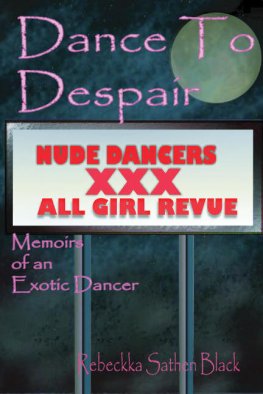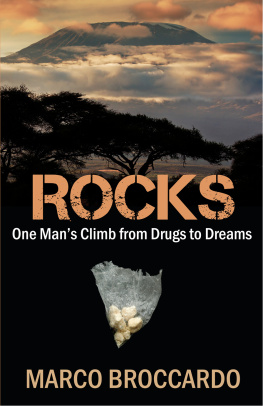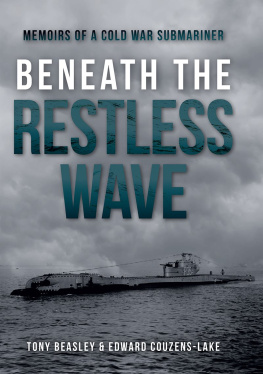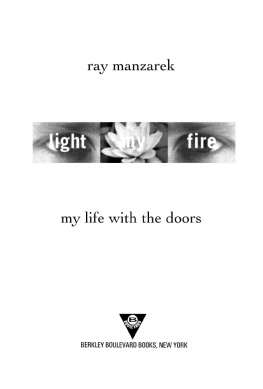Rebeckka Sathen Black
DANCE TO DESPAIR
Memoirs of an Exotic Dancer
Dedicated to the memory of Janis Joplin, whose music accompanied me throughout my career.
Thank you to Michael and Laura Joplin.
My personal thanks to Dawn Botkins for allowing me to gain further insight into the tragic life of Aileen Wuornos, a prostitute and convicted serial killer.
Release me oh Lord from evil men,
protect me from men of violence.
Aileen Carol Wuornos
Death Row, Broward Correctional Institution
Pembrook Pine, Florida 1996
How do you explain where you have spent the last twenty-three years of your life, if you werent married, gainfully employed, or engrossed in some type of a career?
Filling in a twenty-three year gap on a job application can be quite a challenge, even to the best of fiction writers. The bottom line is that if you were to be honest about your past, you would be virtually unemployable. Even an ex-con stands a better chance of attaining employment than an ex-stripper. Because of this, you cant be honest with anyone. Subsequently, your whole life becomes one big lie that you must continue for the rest of your life. Society has proven that it can be quite forgiving of just about anything. Yet, if you would openly confess in a job interview that you had once been a stripper, not even five master degrees would get you in the door of a reputable company. Its very difficult to account to a biased society under these circumstances, but whats even more difficult than having to account for it to other people is having to account for it to yourself.
For many years, I found myself ruminating about all the years of my life that I had wasted working in those seedy places. I felt guilty about not doing something more meaningful with my life, something that I could be proud of. But, every time I confronted my conscience about why I was still dancing, I fell into a deeper depression. Eventually, I became so despondent that I could no longer function. It was at this point in time that I began the life-long process of trying to repair the damaged person that I had become.
I worried about the end of my stripping career almost everyday since I began dancing at the age of twenty-two. I think all the dancers did. Even though most of us hated the business, it provided a false sense of security for us. I can still recall the conversations with the older dancers that were in their thirties and forties.
Our main concerns were how were going to be able to find decent jobs and support ourselves once our stripping careers were over. Would we be able to survive on the meager salary of a straight job? The fear of not being able to survive in mainstream society became our ultimate psychological jailor, keeping us imprisoned in strip clubs for most of our youth.
On top of feeling insecure professionally, most of us suffered from emotional problems, some more severe than others. I would venture to say that at least ninety-five percent of all the dancers that I knew, which were somewhere in the hundreds, came from highly dysfunctional family backgrounds, myself included.
Most had serious substance abuse issues. Only a handful of the dancers were free of drug and/or alcohol addictions. I was fortunate to be one of them. There was, however, one basic commonality none of us escaped the business emotionally unscathed.
In the last ten years, several major motion pictures have surfaced regarding the subject of strippers and or exotic dancers. However, these movies were grossly over glamorized and highly unrealistic to say the least.
Strip clubs have always been a mystery to the average public, and to some extent the authorities that fought for years to shut them down. Outside of an occasional newspaper article about a police raid, the average citizen was and still is virtually clueless as to what really went on in these establishments that lurked within the darkest shadows of their communities.
My intent as a writer is to shed some light on a very dark subject. Dance to Despair is the story of my twenty-three year journey through some of the most dangerous and corrupt adult entertainment clubs ever to exist in the Chicagoland area.
In 1985, the majority of Chicagos most infamous strip clubs were on the verge of closing down due to an intense four-year FBI sting operation, referred to as Operation Safe Bet. The IRS and FBIs 30 million dollar Chicagoland sting operation was originally orchestrated to gather information on crime-syndicated control of sex clubs.
The investigation began in March 1980, when a Chicago man who operated an illicit credit card laundering service, went to the FBI, complaining that the mob was stalking him down for payoffs. FBI officials soon took over the young mans company and placed him in the Federal Witness Protection program. The credit card company was servicing Chicagoland area strip clubs. Male patrons were dropping thousands of dollars a night in these clubs in exchange for companionship from the dancers.
Many of these men charged these services on their credit cards. However, the credit card companies were unaware that the credit card charges were actually being made at a strip club. The clubs operated under a false identity, hiding behind names like R&R Furriers, or Petes Banquet Hall. When it came time for the customer to sign his credit card voucher, the voucher bore the fictitious name, not the actual name of the strip club. This credit card scam went on for some time before it was uncovered. The sting operation consisted of undercover FBI agents operating a credit card service that handled sex club billings.
The Chicagoland area strip clubs literally made a fortune by preying on unfaith-ful husbands, high rollers, and perverts who were willing to spend thousands of dollars in the hope of having sex.
Besides the laundering of money, and the illegal use of credit cards, these establishments hosted a wide variety of other crimes such as racketeering, state fraud, mob connection, drug trafficking, prostitution, savage assaults on club patrons, and in some cases, even on the dancers themselves.
Although this is based on a true story, all characters have been fictionalized. All incidents and geographic locations have been altered and/or fabricated. Any similarity to any person living or dead is not intended and is purely coincidental.
I cant believe that I am still here. I close my eyes a hundred times; and a hundred times they open to this darkness. Its a black abyss, cold and damp, with a cave like feel. There are no windows to exhale the years of exotic perfume, stale cigarette smoke, pest repellents, and sweat. The gloomy cave is crowded with man shadows mesmerized by the electric flames of the stage lights.
The dancers like peacocks are well feathered in bright shiny colors. Contrasting metals dangle from all parts of their bodies, both common and exotic. A woman who has survived in this dungeon has acquired many skills. Soft, sweet voices gig-gle and deceive with practiced innocence. The dancers profit from deceit, but more often than not, they just seek to survive.
Dee Dee Garrett
I aint got no reason for living,
I cant find no cause to die,
I aint got no reason for going,
I cant find no cause to stay here,
I got the blues,
I got to find me that middle road.
Janis Joplin, No Reason for Living
At the age of seventeen years old, I had already enrolled myself into a fairly unorthodox institution, most commonly referred to as the school of hard knocks.
Although the cost of tuition was quite high, I managed to pay for it. As a matter of fact, I paid for it dearly via the last twenty-three years of my life.
When did my problems begin? I dont know, or maybe, I just choose not to remember. Whatever the case may be, I certainly wasnt an under-privileged child by any stretch. Brought up in an upper-middle class community, located in the affluent Chicagoland North Shore, my parents were both very attractive and well educated people. Together, they collectively supplied a nice home for my younger siblings and I, but apparently that wasnt enough; at least not for a child like me. For some reason, I began to exhibit signs of emotional problems as early as ten years of age. By the time I turned thirteen, I was well on my way to becoming a troubled adult. I was different from most of my teenage peers, in the sense that I was totally disinterested in any type of scholastic activities outside of my art classes. I had absolutely no interest in going to college, or even finishing high school, for that matter. Running around with my friends and listening to music was the pinnacle of my existence. I never once thought about my future, because as far as I was concerned, I didnt even have one.








